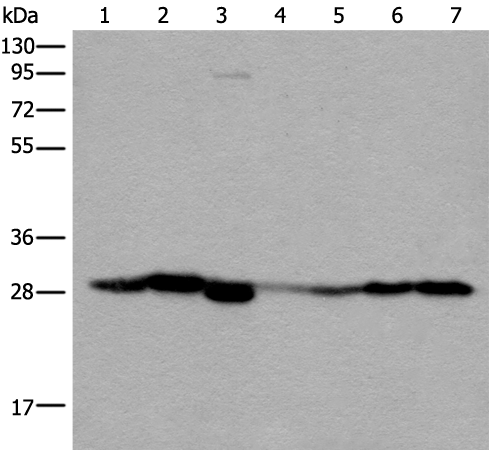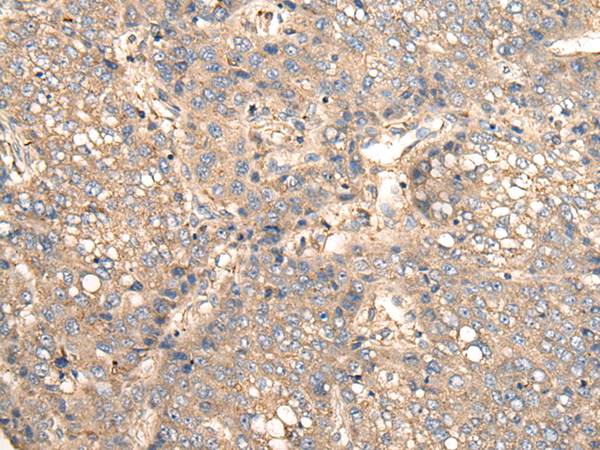


| WB | 咨询技术 | Human,Mouse,Rat |
| IF | 咨询技术 | Human,Mouse,Rat |
| IHC | 1/25-1/100 | Human,Mouse,Rat |
| ICC | 技术咨询 | Human,Mouse,Rat |
| FCM | 咨询技术 | Human,Mouse,Rat |
| Elisa | 1/5000-1/10000 | Human,Mouse,Rat |
| Aliases | VTI1; VTI2; VTI1L; v-SNARE; vti1-rp1; VTI1-LIKE |
| WB Predicted band size | 27 kDa |
| Host/Isotype | Rabbit IgG |
| Antibody Type | Primary antibody |
| Storage | Store at 4°C short term. Aliquot and store at -20°C long term. Avoid freeze/thaw cycles. |
| Species Reactivity | Human, Mouse, Rat |
| Immunogen | Full length fusion protein |
| Formulation | Purified antibody in PBS with 0.05% sodium azide and 50% glycerol. |
+ +
以下是关于VTI1B抗体的3篇示例文献概览(仅供参考,具体文献需自行验证):
---
1. **文献名称**:*VTI1B Contributes to Synaptic Vesicle Exocytosis as a Non-Canonical R-SNARE*
**作者**:Kloepper TH, et al.
**摘要**:该研究利用VTI1B特异性抗体进行免疫沉淀和免疫荧光实验,揭示VTI1B通过与Syntaxin1A等SNARE蛋白形成非经典复合体,调控突触囊泡的胞吐过程,影响神经递质释放效率。
---
2. **文献名称**:*VTI1B Is Required for Autophagosome-Lysosome Fusion in Mammalian Cells*
**作者**:Diao J, et al.
**摘要**:通过VTI1B抗体敲低实验,发现VTI1B在自噬体成熟阶段与HOPS复合体相互作用,介导自噬体与溶酶体膜融合,其缺失导致自噬相关疾病模型中异常蛋白聚集。
---
3. **文献名称**:*Distinct Roles of VTI1B and VAMP7 in Polarized Exocytosis*
**作者**:Linders PT, et al.
**摘要**:研究利用VTI1B抗体标记发现,VTI1B在极化分泌细胞(如肠上皮细胞)中特异性调控顶端运输通路,与VAMP7分工协作,影响细胞极性建立和物质分泌。
---
如需实际文献,建议通过PubMed或Google Scholar搜索关键词(如“VTI1B antibody”、“VTI1B function”),并筛选涉及抗体应用的实验研究。
The VTI1B antibody is designed to target the vesicle transport through interaction with t-SNAREs 1B (VTI1B) protein, a key component of the SNARE (soluble N-ethylmaleimide-sensitive factor attachment protein receptor) family involved in intracellular membrane trafficking. VTI1B facilitates vesicle docking and fusion by mediating the formation of SNARE complexes, particularly in endosomal and Golgi-related transport pathways. It plays a critical role in maintaining cellular homeostasis, neurotransmitter release, and protein sorting.
Antibodies against VTI1B are widely used to study its expression, localization, and interaction partners in various biological contexts. Research has linked VTI1B dysfunction to neurological disorders, such as Alzheimer’s disease, and cancer, where altered membrane trafficking contributes to tumor progression. These antibodies are typically validated in applications like Western blotting, immunofluorescence, and immunoprecipitation, often utilizing models ranging from cultured cells to animal tissues.
Commercial VTI1B antibodies are commonly produced in rabbits or mice, with epitopes targeting specific conserved regions of the protein. Recent studies also employ CRISPR/Cas9-based knockout controls to confirm antibody specificity. As interest in membrane trafficking mechanisms grows, VTI1B antibodies remain essential tools for elucidating its physiological and pathological roles, offering insights into therapeutic strategies for trafficking-related diseases.
×